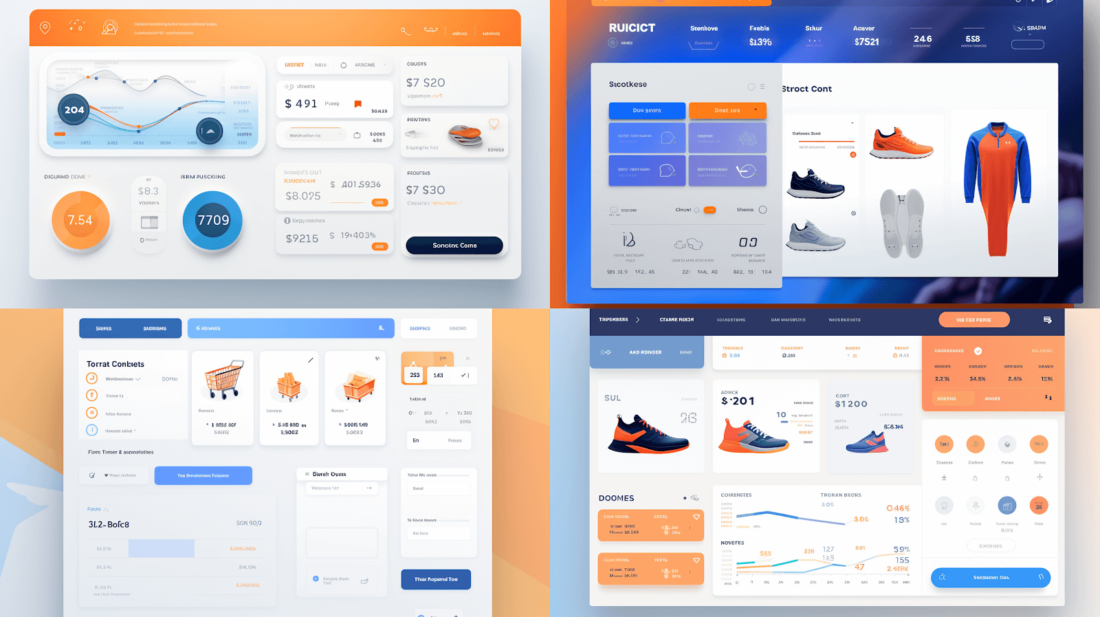
Discover how eCommerce checkout optimization can smooth the path to purchase, offering your customers a quick and secure way to buy from your online store. This article delves into effective strategies that remove obstacles and improve conversion rates.
Key Takeaways on Checkout Optimization
- Streamlining the checkout flow with one-click solutions, progress indicators, and innovative form-filling tools enhances user experience and increases sales conversions on the checkout page.
- Incorporating a customer-centric return policy and providing diverse and flexible payment options, including free shipping, reduce cart abandonment and promote customer trust and loyalty.
- Optimizing the eCommerce checkout process for mobile users, building trust with visible security measures, personalizing the experience, and nurturing customer loyalty post-purchase are essential for eCommerce success.
Accelerating the Checkout Flow
As the digital marketplace continues to grow, so does the competition for customer attention and loyalty. In this context, checkout process optimization has emerged as a critical differentiation in the eCommerce landscape, making checkout process optimization important. An efficient and expedited checkout process enhances the customer’s purchasing experience and substantially elevates eCommerce sales.
One-click checkout solutions, progress bar indicators, and smart form-filling are the three crucial strategies to accelerate this process.
One-Click Checkout Solutions
Imagine a checkout method where shoppers can finalize their purchase with just one click from the checkout page! One-click solutions eliminate unnecessary steps and even remove the guest checkout option by transforming the whole eCommerce store checkout process into a breeze. The brilliance of this approach lies in its simplicity, boosting conversion rates and significantly improving customer loyalty on the checkout page.
A prime example is Amazon’s patented ‘1-Click’ ordering system, which has become the gold standard for streamlining online purchases and enhancing the checkout page experience.
Progress Indicators: Keeping Customers Informed
When shopping online, it’s easy to feel lost and overwhelmed. Progress indicators serve as a guide through the checkout process for customers, alleviating any anxiety they may have. By visually representing the customer’s journey, these tools significantly improve their overall experience and ultimately encourage them to complete their purchases.
An efficient checkout progress indicator should be prominently displayed on the website with simple language that matches the brand’s style. It should also clearly differentiate between completed steps and those remaining to help shoppers keep track of where they are in the checkout process.
Smart Form Filling: Speed and Convenience
Smart forms are a valuable solution for simplifying the time-consuming task of filling out forms on mobile devices, enhancing the checkout page experience. These tools digitize and streamline the process, reducing input errors and ensuring data accuracy during checkout. Some popular smart form options include Typeform, JotForm, Wufoo, and Formstack.
Utilizing these intelligent form tools can enhance user experience by making the form-filling procedure much more convenient for your customers. With features like autofill and real-time validation on these platforms, smart forms speed up the checkout process while improving guest checkout options by streamlining shipping address inputs.
Crafting a Customer-Centric Return Policy
Efficiently optimizing the checkout process involves creating a well-crafted return policy. A generous and flexible return policy and an extended window for returns can establish trust in potential customers and ultimately convert them into paying buyers. Transparency and accessibility of the return policies also foster business and build customer loyalty. It is common for most online retailers to have a standard 30-day period for returns.
To boost sales revenue, offering exchanges or store credits instead of refunds through checkout can encourage returning customers, mainly if free shipping is provided on these transactions.
Streamlining Cart and Basket Pages

The final stop for customers before purchasing is the cart and basket pages. To encourage shoppers to follow through with their purchases and reduce cart abandonment, minimizing clutter on these pages is crucial. Simplifying choices by providing personalized recommendations enhances the shopping experience and prevents decision paralysis that could lead to cart abandonment.
A smooth transition from the cart page to the checkout page is essential in reducing any obstacles for shoppers and clearly showing them how to complete their purchases. Ensuring various payment options, a flexible return policy, and the ability to offer free shipping addresses common concerns that lead to abandoned carts. These features demonstrate an understanding of customer hesitations and provide reassurance, which can improve conversion rates. A complicated checkout process should be avoided as it may deter customers from finishing their transactions smoothly. By keeping a simple and efficient checkout process, customers are more likely to purchase successfully.
Enhancing Payment Flexibility
The pivotal moment in an eCommerce transaction is the payment phase. Giving customers different preferred payment method options, including safeguarding their credit card details, considers their diverse preferences, which demographics, location, and personal management habits can influence. Offering various payment options that cater to customers’ preferred methods helps reduce friction during the transaction process; this leads to lower cart abandonment rates, boosts satisfaction levels, and fosters customer loyalty, giving businesses a competitive edge in the market. Companies can accommodate a broader range of customer needs and preferences by ensuring that multiple payment options are available and presented, further enhancing the checkout experience and reducing the likelihood of cart abandonment. Understanding the reasons behind cart abandonment and addressing them through payment flexibility is a strategic move to prevent lost sales and improve customer retention. Moreover, analyzing cart abandonment trends can provide insights into customer behavior, allowing for better tailoring of payment options to meet customer expectations and minimize cart abandonment.
Addressing False Declines in Payment Acceptance
Incorrectly blocked transactions due to the activation of fraud detection systems are known as false declines. These occurrences can result in direct financial loss and harm customer relationships, potentially causing future missed opportunities for sales. Assessing declined transactions and obtaining feedback from customers can aid in identifying and addressing patterns that lead to false declines.
Businesses can also decrease the occurrence of false declines by incorporating advanced fraud prevention technologies utilizing machine learning techniques and adjusting their anti-fraud settings based on typical transaction behaviors.
Integrating Seamless Payment Gateways
Payment gateways are crucial in connecting merchants and their customers in online business. Their primary function is ensuring that transactions are executed efficiently and securely, enhancing the overall checkout process. Popular integrated gateways such as Checkout.com and Stripe enable seamless payments on eCommerce sites while providing speedy setup, multiple payment options, and advanced 3DS for improved compliance with SCA regulations.
These gateway solutions assist businesses in maximizing legitimate payment acceptance without compromising fraud prevention measures. With their help, companies can offer an uninterrupted checkout experience to customers while maintaining strict security standards
Building Trust with Security Measures
In the digital world, one of the top concerns for customers is security. This includes safeguarding their credit card information. Displaying different security badges, such as SSL certificates and PCI DSS compliance, can instill trust in users and ultimately increase conversion rates. Placing these trust badges strategically on high-traffic pages ensures maximum impact without causing any distractions.
To build customer confidence, it is essential to make privacy policies easily visible to shoppers. By addressing potential security concerns and showcasing a commitment to protecting customer data, displaying privacy policies on eCommerce websites can enhance user trust significantly.
Personalizing the Checkout Experience

In the competitive world of e-commerce, personalization isn’t just an extra—it’s essential for meeting the high expectations of online consumers. Tailoring the checkout experience to align with each customer’s preferences boosts satisfaction and can drive higher sales.
To achieve this level of customization, businesses can utilize Customer Data Platforms (CDPs) to gather and analyze customer data. This includes considering consumer behavior, location, preferences, and device usage patterns. Personalized product recommendations can be made during checkout to cater to online shoppers’ unique tastes and needs.
Furthermore, personalized discounts or promotions based on specific customer preferences are another effective way to enhance overall satisfaction and encourage increased spending.
These strategies have been proven to improve the customer experience and the average order value (AOV). Success in personalization is elevated by implementing targeted upselling techniques at strategic points during checkout. Cross-selling opportunities that arise throughout the purchase journey are also key areas where personalization tactics have positively impacted AOV numbers.
Incorporating personalized elements into the checkout process has become crucial for any successful eCommerce business. Through using CDPs and leveraging various aspects like user behavior and preference-based recommendations alongside targeted offers, companies stand a greater chance at delivering ultimate shopping experiences to online shoppers while maximizing profits through increased cross-selling potential inherent within each unique sale opportunity arising throughout every seamless purchasing cycle.
Optimizing for Mobile Shoppers

As the number of people using smartphones to shop for eCommerce businesses online grows, it is increasingly vital for eCommerce stores to optimize their checkout process for mobile devices. This means having a responsive design suitable for smaller screens, clear call-to-actions, and a simple layout that keeps customers focused on completing their purchases.
Regarding mobile checkout pages, speed and performance are crucial in meeting customer expectations for a seamless device experience. These pages should load quickly without any issues so as not to disrupt the smoothness of the purchasing process.
Encouraging Customer Loyalty Post-Purchase
After customers make a purchase, the customer journey doesn’t come to an end. It’s crucial to continue nurturing their loyalty post-purchase because existing customers are more likely to repeat purchases than new potential buyers. Providing incentives for repeat purchases can significantly improve customer loyalty. Studies have shown that users who use one-click checkout have a 9% higher repurchase rate, and reward programs that offer freebies in exchange for accumulated points also encourage returning customers.
One way of deepening relationships with post-purchase communications is by sending out mobile-friendly order confirmations and personalized thank-you messages or gifts. This shows appreciation for their business and encourages future interactions with them as valued customers.
Leveraging Live Chat Support

Picture shopping in a brick-and-mortar store where no staff can assist you. It can be pretty frustrating, right? The same applies to the online shopping experience. By incorporating live chat support, businesses can significantly increase their conversion rates.
One of the significant benefits of having live chat support is that it leads to higher customer satisfaction levels through various means, such as providing immediate assistance and adding a personal touch to customer interactions. This feature also boosts engagement by offering an interactive platform for customers during their online shopping journey.
Frequently Asked Questions
What is checkout optimization?
eCommerce merchants employ various techniques to simplify the checkout process for their customers. The aim is to create a seamless, user-friendly experience that promotes higher conversion rates and encourages loyal, repeat purchases. These strategies are collectively known as “checkout optimization.” This involves improving the eCommerce site and checkout system so it becomes more efficient and easier to use.
How can I improve my checkout conversion?
To improve your checkout conversion, consider enabling “add to cart” from all pages, offering multiple delivery options, introducing delivery options and prices early, offering free shipping, using a mini cart, cross-selling and upselling, allowing guest checkout, setting expectations, and showing progress.
These tactics can help streamline the checkout process and increase conversions effectively.
What is a reasonable checkout rate?
A reasonable checkout rate is generally considered above the average completion rate of 48.6%, with rates above 63.8% and a conversion rate above 71.4%, putting you in the top 20% and 10% of online businesses, respectively.
Aim for a rate above these benchmarks to indicate your online store and sales success.
What role does speed play in the checkout process?
Efficient and prompt transactions during the checkout process are crucial in enhancing the customer journey, ultimately leading to increased eCommerce sales. Ensuring a seamless and speedy experience is critical to achieving high customer satisfaction and revenue growth.
How does a return policy affect customer loyalty?
An easy-to-understand, open, and fair return policy can significantly enhance customers’ confidence in your business. This trust leads to customer loyalty, which is essential for building lasting customer relationships.
Summary
Effective checkout optimization is key to boosting sales and enhancing customer satisfaction in the dynamic realm of eCommerce and retail. Essential tactics for streamlining the eCommerce checkout process, crucial for an efficient checkout flow, include implementing one-click solutions, progress indicators, and smart form-filling. These methods are vital for simplifying and accelerating the eCommerce checkout experience. Emphasizing customer-centric policies, such as flexible returns and diverse payment options, significantly reduces cart abandonment and builds loyalty.
Furthermore, adapting to mobile users, ensuring security, personalizing the experience, and fostering post-purchase loyalty are important aspects of a successful eCommerce strategy. Partnering with Koombea can be particularly beneficial in this endeavor. Koombea’s expertise in digital solutions positions it as an ideal ally for businesses seeking to enhance their checkout processes. Their tailored strategies can lead to higher conversion rates and a smoother shopping experience. For companies aiming to refine their eCommerce strategies and provide an efficient, secure checkout, Koombea offers invaluable support, making it a great partner for achieving checkout optimization success.
